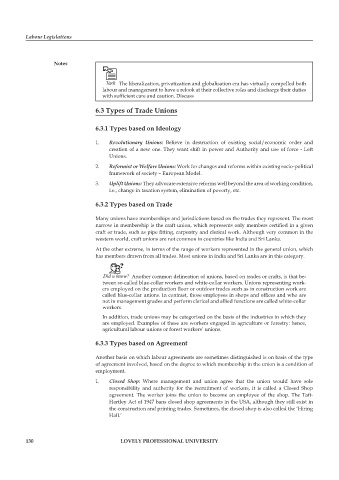Page 135 - DMGT516_LABOUR_LEGISLATIONS
P. 135
Labour Legislations
Notes
Task The liberalization, privatization and globalisation era has virtually compelled both
labour and management to have a relook at their collective roles and discharge their duties
with sufficient care and caution. Discuss
6.3 Types of Trade Unions
6.3.1 Types based on Ideology
1. Revolutionary Unions: Believe in destruction of existing social/economic order and
creation of a new one. They want shift in power and Authority and use of force - Left
Unions.
2. Reformist or Welfare Unions: Work for changes and reforms within existing socio-political
framework of society – European Model.
3. Uplift Unions: They advocate extensive reforms well beyond the area of working condition,
i.e., change in taxation system, elimination of poverty, etc.
6.3.2 Types based on Trade
Many unions have memberships and jurisdictions based on the trades they represent. The most
narrow in membership is the craft union, which represents only members certified in a given
craft or trade, such as pipe fitting, carpentry and clerical work. Although very common in the
western world, craft unions are not common in countries like India and Sri Lanka.
At the other extreme, in terms of the range of workers represented in the general union, which
has members drawn from all trades. Most unions in India and Sri Lanka are in this category.
Did u know? Another common delineation of unions, based on trades or crafts, is that be-
tween so-called blue-collar workers and white-collar workers. Unions representing work-
ers employed on the production floor or outdoor trades such as in construction work are
called blue-collar unions. In contrast, those employees in shops and offices and who are
not in management grades and perform clerical and allied functions are called white-collar
workers.
In addition, trade unions may be categorised on the basis of the industries in which they
are employed. Examples of these are workers engaged in agriculture or forestry: hence,
agricultural labour unions or forest workers’ unions.
6.3.3 Types based on Agreement
Another basis on which labour agreements are sometimes distinguished is on basis of the type
of agreement involved, based on the degree to which membership in the union is a condition of
employment.
1. Closed Shop: Where management and union agree that the union would have sole
responsibility and authority for the recruitment of workers, it is called a Closed Shop
agreement. The worker joins the union to become an employee of the shop. The Taft-
Hartley Act of 1947 bans closed shop agreements in the USA, although they still exist in
the construction and printing trades. Sometimes, the closed shop is also called the ‘Hiring
Hall.’
130 LOVELY PROFESSIONAL UNIVERSITY

